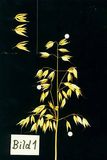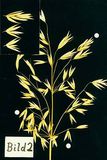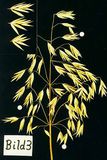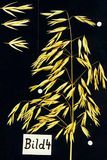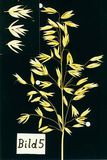Breeding naked spring oat for organic farming
At Darzau we do breeding and research with naked/hulless spring oat under and for organic farming. In particular varieties with resistance to loose smut are selected to manage continuos organic seed multiplication on organic farm level. Additional attention is given to hairless and shortened grain without any hulls. Last not least the kernels should be shiny and tastefull with a high sprouting resistence.
Last changed: 07.05.2012
Naked Oats for Human Consumption
Development of a head-blight resistant, almost completely husk-free edible oat with without hairy grains, which achieve a high viscosity during processing.
The oat flakes available on the market are usually made from oat with a husk. By moistening and kilning the husks are made brittle and can then be separated more easily. This thermal treatment results in denaturation of the oat's proteins so that the fats can no longer be enzymatically modified, which slows down rancidity and increases shelf life. In addition to the need for oat flakes, there is also an interest in whole undamaged oat kernels for use in whole grain wholefood. For this purpose, husk-free oats ("naked oats") are cultivated, but they often offer only a small yield of marketable product. A problem is also the proportion of husked grains, which must always be removed with losses of husk-free grains. In addition, there are large losses due to broken grains due to excessively long and narrow grains and too wide grading of the grains in the crop from very small and almost round to large and long. The yield of marketable goods is therefore often only 50% of the harvest; the rest has to be fed.
The following pictures with different panicle types contain three spikelets each from the lower, middle and upper part of the panicle in the upper left corner. A white dot on the panicle indicates the place where the spikelets were taken. Each spikelet contains several flowers and one seed is formed per flower. The link from flower to flower is called the stem.
On the panicle of the spelt oat (Fig. 1) there are typically spikelets with 2-3 flowers. If spikelets with two or three flowers are present in a panicle, the two-flowered ones are more in the lower, central part of the panicle, the three-flowered ones in the upper and peripheral part. In between, spikelets can be found which have three flowers, but where the third is insufficiently developed and often atrophied. The transition from the central to the peripheral part of the panicle is additionally accompanied by a more or less distinct increase in length of the spikelets. This is the connection between the individual flowers of a spikelet. Also, the stems are usually shorter between the first and second flower than between the second and third flower.
The differences in the structure of the spikelets from the central to the peripheral panicle area can be much more pronounced (Fig. 2). Both an increase in stem length and in the number of flowers per spikelet to up to five can then be observed. In this case, too, the stems within an spikelet are shorter between the first and second flower than between the second and third flower. In parallel with the elongation of the spikelets, the oat kernels of the peripheral and at the same time more multi-flowered spikelets with extended stems are only slightly coated by increasingly softer glumes. The basal-central, three-flowered and short-stalked spikelets have grains which are firmly enclosed by leathery glumes. The crop of such panicles contains a considerable proportion of furred oat kernels.
The multi-flowering can also start in the lower panicle area (picture 3). In this case, the oat kernels are already predominantly glume free and the still husked kernels come from spikelets from the central-basal area of the panicle; within the spikelets from the second or third flowers. The first flower of a spikelet already releases the grain from the somewhat softer glumes. Also in this type of panicle, the stems are shorter between the first and second flowers than between the second and third flowers.
The emerging development of stem elongation and multiflowering in combination with husk-free threshing may be even more pronounced (Fig. 4). Under these conditions, after sieving and wind sifting, no more husked grains are found in the crop. However, as can already be seen from the large number of flowers and the length of the spikelets, the oat kernels in the crop are long, narrow and thus very sensitive to breakage, and within one spikelet they become smaller and smaller towards the tip. In addition, the very long stems can easily break through in stormy weather. This type of panicle is less recommended for practical cultivation. However, it does point to a connection that is of interest for further breeding.
Within a spikelet the stems shorten steadily and are longest between the first and second flower of a spikelet. In all previous panicle types, the stem was shorter between the first and second flower than between the second and third flower of an spikelet and, as a result, there was a tendency for furred grains to appear. According to comparative observations, it is this compression in the spikelet that is associated with firmer glumes that do not come off during threshing. This points the way to the solution of the practical problem.
There should be panicle types that have only 3-5 flowers per spikelet, but where the stem is longer between the first and second flower than between the second and third, and so on. If this characteristic were well developed, then all oat kernels would be free threshing and the stems would not break as easily as those of the 5-9 flowered spikelets, and grain grading would be more balanced. When this correlation was recognized, a panicle was found which is already very close to this type and combines the desired properties (Fig. 5). The somewhat more oval-shaped kernels were also less prone to breakage during threshing and preparation. Under practical conditions, the yield of marketable material is already around 70%. This edible sack oat is registered under the name "Nusso" in the Aberdeen, Idaho, USA gene bank under the number PI 564722 and in the Braunschweig-Völkenrode gene bank under the number BGRC 66223.
The relatively soft seed of spelt free oat requires careful handling. Slight damage to the fine seed coat leads to spoilage (impairment of taste and loss of germination capacity) due to the high fat content typical of oats. Compared to oat with glomerules, the grain is also not as well protected against drying out after germination has begun. Due to higher losses after sowing, a seed strength of 420 germinable grains/m² (approx.120-150kg/ha) or 20% more grains/m² compared to spelt oats is recommended. When sowing, it should be taken into account that due to the slower flow characteristics of the grains in the seed box caused by grain hairiness, there is always enough seed to press on so that no gaps occur in the crop later.
Longer dry periods during vegetation lead to firmer husks and may thus increase the occurrence of furred grains in the crop. This can be counteracted by early sowing, which delays the start of the shoot, leaving more time for the panicles and spikelets to grow. The spikelets are then larger and the glumes softer due to longer stems. When sowing very early, especially on light soils, increased birdfeed is to be expected if the sowing depth is low. Therefore the planting depth should be at least 2-3 cm.
During harvesting and preparation care must be taken to ensure that the grain is not subjected to excessive mechanical stress. The distance between the concave and the beater bars in the combine harvester should be chosen just as close as necessary and the concave speed as low as possible. If possible, the grain should also have already matured down to 15% moisture (due to the fine hairiness of the grain and its softness, the moisture content is easily misjudged by sensory inspection).
In order to prevent any loss of quality in terms of taste due to heating in storage, drying or air cooling should be carried out immediately after harvesting. During preparation (cleaning), the number of operations should be kept to a minimum to protect the grain. The use of a brush to reduce grain hairiness may lead to considerable loss of germination capacity, which must be taken into account with regard to further use (sowing or sprouting grain). With an average seed cleaning in conjunction with a light grain separator ("table"), a very good product can generally be obtained with a low quantity of waste grain. According to a survey of trial growers, the yield of marketable product from an almost completely husk-free oat amounts to approx. 70% of the harvest.
When using one's own harvest for reseeding, a technical and genetic mixing with spelt oats should be avoided, as spelt oats in edible oats have a natural selection advantage and can increase proportionally rapidly over the years. Care should therefore be taken to ensure sufficient distance (at least 500m) from other oat fields, especially those with spelt oat varieties, or the core area should be harvested separately. With the equipment used (e.g. sowing machine and especially combine harvester) care must be taken that it is seed clean.
Last updated : 07.05.2012
